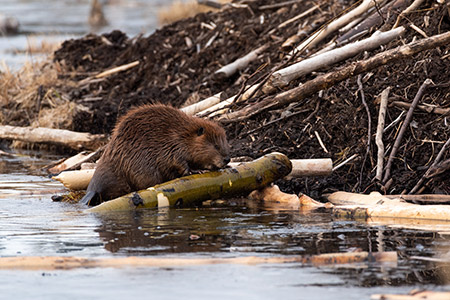Best Snares For Beavers
 Why use snares?
Why use snares?
Snaring is one of the most effective methods for catching beavers. Much more cost-effective than other methods, snares can be used in either slides currently being used by beavers or in slides you create.
Beavers are unique and require some special attention when it comes to snaring. Unlike many animals, beaver snares are set for body catches. Why? Check out our tips below to help you properly and effectively set beaver snares.
Beaver Facts to Encourage Successful Snaring
Beavers are relatively intelligent creatures, so proper use of snares is required at all times. Additionally, the anatomy of a beaver is such that proper snare placement and setup is crucial. Many animals caught with snares have a head that is larger than the neck area. This helps successful snaring, because it makes it difficulet for an animal to back out of a snare once it has started to tighten. Because a beaver’s head and neck taper into its body, it is much easier for a beaver to back out of a snare that it is for other animals.
When snaring beavers, you’re aiming for a body catch with the ideal location being directly behind the front shoulders. If the front feet of a beaver pass through the snare and the snare begins to tighten, it is highly unlikely that the beaver will be able to back out of the snare without causing the snare to tighten further.
Choosing Proper Locations for Beaver Snares
As with most animals, beavers tend to follow the easiest route for travel. When setting snares near water, it’s best to not place the beaver snare in the water, but at the immediate edge of the water. This gives you the best opportunity to snare the beaver as it emerges from the water. You can also position your snare along the route to slides used by beavers, but it is generally advisable to place a snare where a beaver will exit the water whether that’s a feed trail or castor mound. Narrow creek passages are also a potential location for beaver snares.
Beaver Snares and Other Equipment
One of the most attractive things about snaring is that it requires minimal equipment. Aside from the snares, you will need gloves, wire, and pliers. If you haven’t prepared snares for use before, check out our guide to proper snare preparation. Once your snares are boiled and fully prepared, it’s important to handle them with clean gloves.
Human scent can be a major deterrent to animals, including beavers, when it comes to passing through a snare. The ideal gloves to use are cotton or knit gloves that fit your hand well. Gloves are important because they help to minimize human scent transferred to the snares. Cotton or knit are preferable because they can be easily washed, which will help reduce human scent after use.
You will also need wire to anchor your snare, pliers that are able to bend and cut wire, and fencing materials such as logs, standing trees, or broken branches. Typically, beavers do not show an aversion to fencing, which is helpful for trappers. Fencing is achieved by placing something directly in a beaver’s path so you can encourage it to travel in a certain direction. You may also want to place fencing, such as smaller sticks beavers have previously chewed, around the snare so you can be sure that the only travel path a beaver has is directly through the snare.
With proper setup and preparation, beaver snares are incredibly effective. For more information, or to see what we offer, check out the products we offer.
.png)

